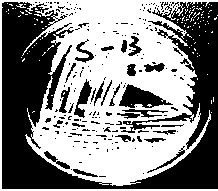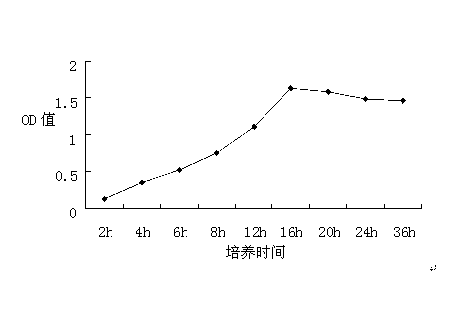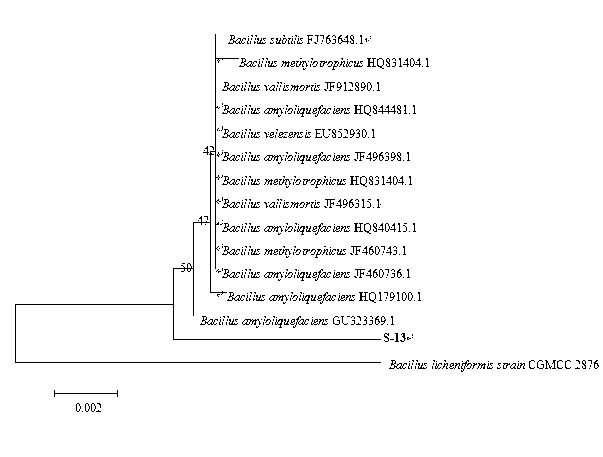Antagonistic bacterium cooperating with AMF for disease resisting and growth promoting and application thereof
A technology of antagonistic bacteria and bacilli, applied in the prevention and control of soil-borne diseases of vegetables, in the field of agricultural microbial applications, can solve the problems of long continuous cropping cycle, difficult control, and prone to pests and diseases, and achieve the reduction of pesticide usage, good antagonistic ability, The effect of increasing crop yield
- Summary
- Abstract
- Description
- Claims
- Application Information
AI Technical Summary
Problems solved by technology
Method used
Image
Examples
Embodiment 1
[0027]Embodiment one: bacillus amyloliquefaciens ( Bacillus amyloliquefaciens ) Isolation, screening and identification of CGMCC No. 6491
[0028] (1) Isolation and screening of antagonistic bacteria
[0029] Multiple strains of bacteria were isolated from farmland soil samples by gradient dilution method, and whether they had antagonistic effect was judged by the plate confrontation method according to the presence or absence of inhibition zones. Certain antagonistic strains. The second confrontation experiment was carried out on the strains with antagonistic effect, and the strains with stronger antagonistic ability were screened out for subsequent experiments.
[0030] Re-screening obtained a bacterial isolate with good antagonism against the pathogenic bacteria of tomato fusarium wilt, cucumber wilt pathogen, and capsicum phytophthora, which was named S-13. It can obviously inhibit the growth of pathogenic mycelia after 72 hours of cultivation. After many experiments I...
Embodiment 2
[0044] Embodiment two: bacillus amyloliquefaciens ( Bacillus amyloliquefaciens ) Growth factor of CGMCC No.6491
[0045] Refer to following mode, but should be according to the bacillus provided by the invention ( Bacillus amyloliquefaciens ) CGMCC No. 6491 characteristics to determine its specific growth factors.
[0046] Strain S-13 was inoculated. The results are shown in Table 2.
[0047] It can be concluded from Table 3 that strain S-13 is the most suitable growth factor.
[0048] temperature (°C) 4 15 25 30 32 35 growing situation — + + +++ ++++ +++ temperature (°C) 38 45 50 growing situation ++ + — pH 1 2 3 4 5 6 growing situation — — — — + ++ pH 7 8 9 10 growing situation +++ + — — NaCl concentration 0.5% 1% 2% 3% 4% 5% growing situation + ++ +++ +++ +++ + NaCl concentration 6% 7% 8% 9% 10% growing situation — ...
Embodiment 3
[0050] Embodiment three: bacillus amyloliquefaciens ( Bacillus amyloliquefaciens ) Research on the fermentation process of CGMCC No. 6491
[0051] Antagonist S-13 is a strain of Bacillus. In order to better apply it and play its role in production practice, we expect to be able to produce a large number of spores by optimizing the culture medium and culture conditions, which will not only help save future The processing cost is more conducive to the maintenance of its activity. The purpose of spore production is achieved through the optimization of carbon, nitrogen source, pH value, etc.
[0052] (1) Determination of culture medium and pH
[0053] According to the pH value of 6.0, 6.5, 7.0, 7.5, 8.0, ferment at 220 r / min, temperature 30 ℃ to get the optimum growth pH value.
[0054] (2) Growth curve and culture conditions
[0055] Table 3 pH optimization results
[0056] 6.0 6.5 7.0* 7.5 8.0 S-13 0.288 1.357 1.463 1.421 0.088
[0057] See at...
PUM
 Login to View More
Login to View More Abstract
Description
Claims
Application Information
 Login to View More
Login to View More - R&D
- Intellectual Property
- Life Sciences
- Materials
- Tech Scout
- Unparalleled Data Quality
- Higher Quality Content
- 60% Fewer Hallucinations
Browse by: Latest US Patents, China's latest patents, Technical Efficacy Thesaurus, Application Domain, Technology Topic, Popular Technical Reports.
© 2025 PatSnap. All rights reserved.Legal|Privacy policy|Modern Slavery Act Transparency Statement|Sitemap|About US| Contact US: help@patsnap.com



